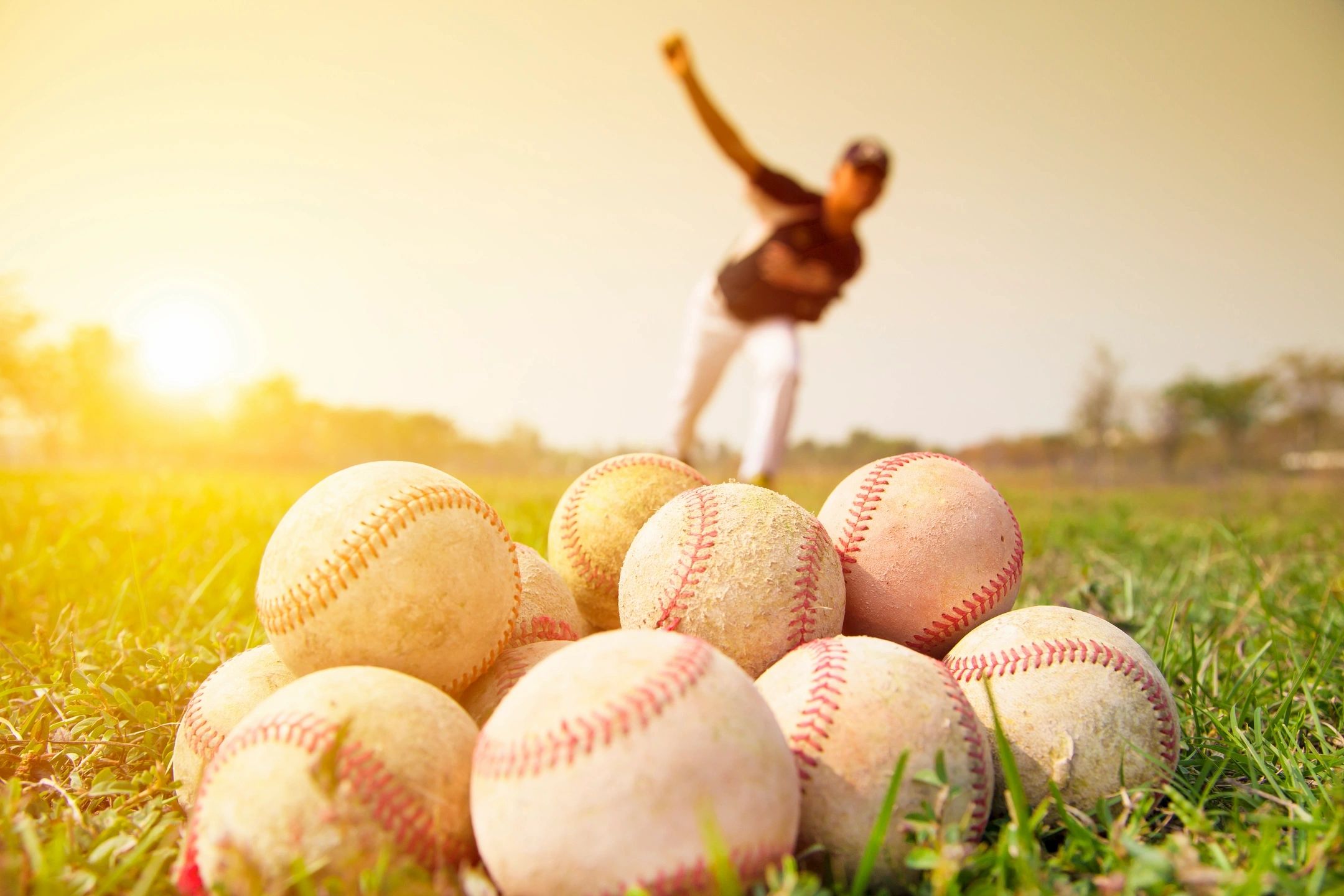This is for the Nerds: Aerodynamics of Pitching
Written September 2023
Strike Three! Baseball fans love that call (well unless your team is batting). Pitchers have all sorts of unique ways to strike out batters. A famous pitching coach once said “Batting is timing; Pitching is upsetting timing”. Maybe we heard commenters say “And the curveball gets him… Fastball upstairs! … Slider down and away!” and maybe you know what all those pitches look like on television–but how do pitchers throw them?
I was a pitcher back in the day with my own repertoire and I loved testing out different pitches to see which I could master the best. Here are some pitches and how they “work”. If you’re a baseball pitcher yourself, don’t be afraid to test them out (just maybe in practice before a real game).
Fastball
Fastball is the primary pitch in the baseball. Everything is built off of this pitch. There are 4-6 common fastball pitches but for sake of this article I’ll mention the most common: the Four-Seam Fastball
This is because your fingers are across the seams and touch the seam in 4 locations. Aerodynamically this is the fastest and the most ‘straight’ of a pitch one can throw. This is because there is a consistent backspin with limited angular motion. Like an airplane, the air underneath the ball becomes less dense relative to the top of the ball and creates lift through a fluid (in this case the fluid is air!). This is called the Magnus effect.
Find out the Fastball Effect with respect to Global Monetary Policy by clicking here!
Some have called this a “rising fastball” given the lift component, which is mechanically incorrect (for something to rise it would need to possess more energy put into it and the most energy you put into it is when it leaves your hand!) Instead of rising, its more accurate to say “not falling fastball”. Hence, the net result is the ball continues to travel straight and accurately.
Curveball
Now that you know that a Four-Seam Fastball travels straight because of it’s backspin, what would topspin (spinning forward) do? This is a curveball!
The objective is to not pull down on the seams so the ball rolls off the tip of your fingers but to cock the hand 90* to “get on top” of the ball to rotate the ball spinning forward.


A curveball will break down at a certain point as it reaches home plate. Some curveballs has true top spin and break “12-to-6” (imagine numbers on a clock) which just means straight down others have a little bit of a side-component “1-to-7” or “2-to-8” type break.
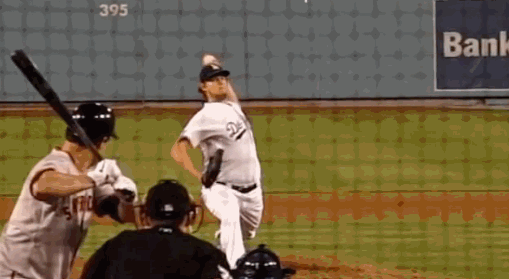
Whereas the fastball creates lift from a lighter air density on top of the ball, the curveball is the opposite. The topspin generates more dense air on top of the ball and pushes it down or “drops”. I’m glad airplane wings don’t work like curveballs…
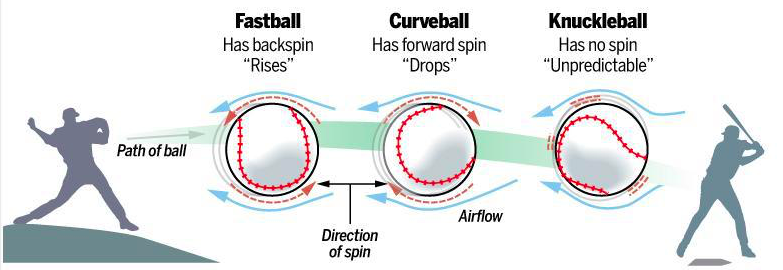
Slider
A slider is one of the most effective pitches due to it’s significant, late break and it’s speed relative to a curveball. A slider can be “tight” or it can be “loose” which dictate the level of movement but generally it is thrown like a fastball but one “cuts” their middle and index finger through the side of the ball or seams creating a mixture of spins. The ball spins forward (top-spin) like a curveball but also sideways (perpendicular spin to the direction of the ball) like a bullet. The net spin result is the ball appears to “slide” away in mid-air. It’s kind of a hybrid between a curveball and fastball in terms of speed + a side movement component. Very tough to hit!
If you can imagine a ball to have backspin, topspin and sidespin there are 3 axis that a ball can rotate. Pitchers utilize the latter two by pulling down on the side of the ball.


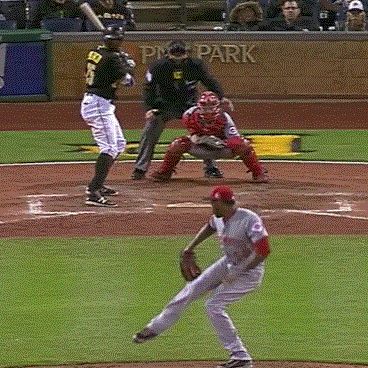
Knuckleball
Okay, to the weirdest and most interesting. The “Knuckler”. These four pitches all work because of their types of spin, which can make the ball travel straight, drop or slide. The pitcher and the catcher are aware of this. But what if, nobody knew? It’s chaos, but you can be sure the batter will be confused. A knuckleball works by trying to remove as much spin from the ball as possible.
The result here is that the air “bounces” off of the seams and sends it in a random direction. The ball sometimes is said to be “dancing” because it’s possible to travel in two different directions in the same flight. This is done by holding the ball with your fingernails exposing your knuckles (hence the name) and throwing it with a stiff wrist so the ball should come out of your hand stationary.
Pitchers can’t pitch it, hitters can’t hit it, catchers can’t catch it and coaches can’t coach it–The Perfect Pitch
The Knuckleball
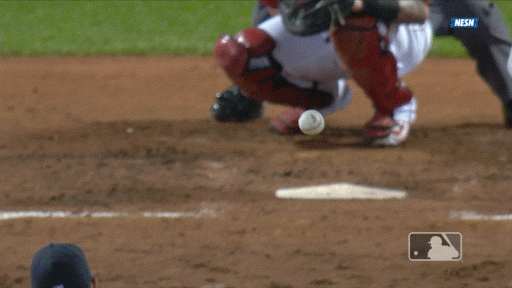
The stitches knock the ball off-course as it pierces the airflow to cause turbulence. To use an airplane analogy, an aircraft is designed with a slick thin design so it can cut through the airflow smoothly so you’re not bouncing around when eating your peanut snack. A knuckleball is like having a near square shaped airplane–the air is fighting to get ‘around’ the plane (or ball) so it’s always turbulent. Just like the pitch, it would be dancing around all over the place.

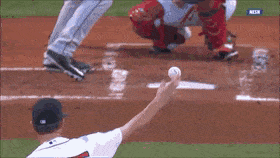


I hope this was interesting for you! What’s your favourite pitch? Please feel free to share!
Now, time to get off the computer/phone and play ball!
#StayOnTheBall
